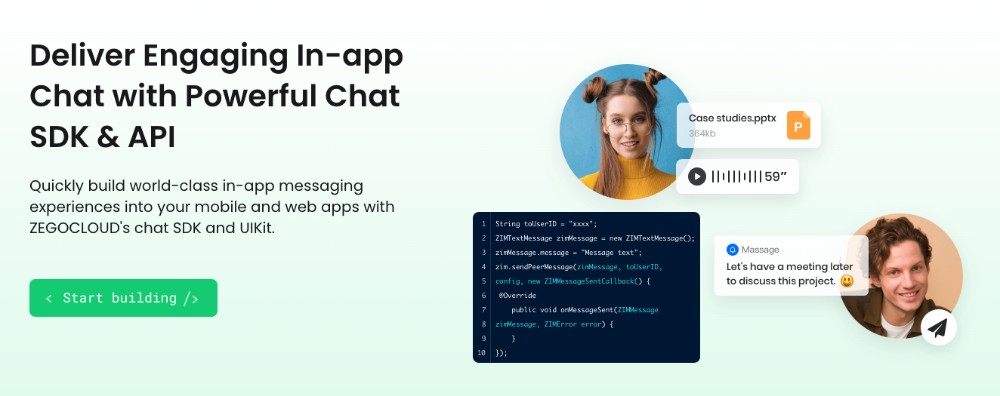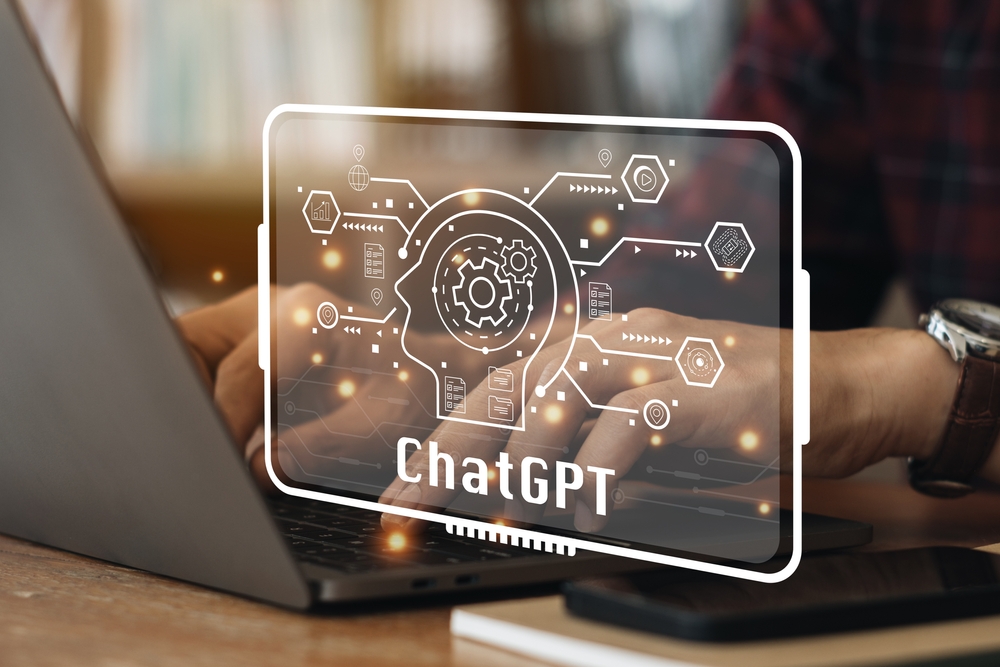ChatGPT made its debut and astounded the world with its revolutionary communication and content-producing capabilities. The AI-powered chatbot quickly gained popularity, amassing millions of users in a few days, and alarmed the world’s major search engines.
No wonder why, months after its debut, artificial intelligence (AI) is making its way to Internet search, with Google, Bing, and Baidu announcing plans to incorporate ChatGPT’s model into their search offerings. Instead of obtaining a list of links after inputting a keyword or phrase, this will allow people to get direct answers or engage in a dialogue.
Let’s take a closer look at ChatGPT and how it’s changing the way we live and work online. Finally, we will explore the innovative Chat API of ZEGOCLOUD, a real-time communication solution for apps that simplifies and enriches the instant messaging experience.

What is ChatGPT?
ChatGPT stands for “Chat Generative Pre-trained Transformer,” a rudimentary chatbot powered by artificial intelligence. It is based on a rather popular AI model called Gpt-3 that can synthesize sentences based on patterns absorbed from massive quantities of text acquired from the Web.
For many, a fantasy came true; for others, a disruptive nightmare. Its prototype was created by OpenAI, a non-profit organization dedicated to exploring artificial intelligence and encouraging friendly AI. Elon Musk is one of its founders, albeit no longer part of it.
Its success is due to its powerful machine learning model and meticulous work on supervised learning of the instructors on Microsoft’s Azure cloud. This enabled ChatGPT to create consistent natural language texts and answers based on the input received using machine learning algorithms. These are known as Large Language Models (LLM).
How Does LLM Work?
ChatGPT uses machine learning algorithms to create consistent natural language messages and answers based on the input received. Algorithms based on this paradigm can evaluate massive volumes of textual data and determine statistical correlations (patterns) between one word and another. Consequently, they can guess one word after another and write a response. This model is usually referred to as next-token prediction and disguised language modeling.
Because of increases in processing power, these models have risen in popularity in recent years. ChatGPT, in particular, was created using reinforcement learning from human input (RLHF). The strategy aims to eliminate wrong replies by correcting and rewarding the right answers.
What Can ChatGPT Do?
What this super AI-powered chatbot is capable of is astonishing. It’s like it has the talents of a copywriter, developer, teacher, marketer, and so on. And also great students, having passed all of their school and university examinations and tests where they tried with flying colors. As a chatbot, this tool conveys itself through texts with knowledge comparable to, if not superior to humans. As a result, several countries, including the United States, France, and Australia, banned ChatGPT use in theses and academic research.
It can perform the following:
- Questions and answers ( based on existing knowledge)
- Grammar improvements
- Condensing complicated text into basic principles
- Turn long text into a few sentences or a table and idea mapping
- Translations into other languages
- Writing computer code
- Writing articles
And a lot more. Companies that strategically employ technology can benefit greatly from tools like ChatGPT. Chat-based artificial intelligence can help people operate more efficiently by automating monotonous jobs and offering more exciting interactions with users and clients.
Some examples of how businesses may use ChatGPT include:
- Compiling research
- Brainstorming ideas
- Automating elements of the sales process
- Streamlining and enhancing procedures using automation
- Improving the customer onboarding process and aftercare services
- Content production and copywriting
Yet, experts point out that it has significant limits and weaknesses, such as superficiality, repetition, and absurdity. Just like humans, after all.

Limits and Problems of ChatGPT
OpenAI acknowledges the limits of its model.
The model is lengthy, which means it has a flat style and misuses several phrases. It is possible that it provides convincing yet wrong or illogical replies or fails to do computations. ChatGPT understands statistical relationships between words but not relationships between terms and the world. For this reason, ChatGPT frequently has “hallucinations,” confusing reality with fiction. Despite filters, these issues can foster disinformation, particularly in sensitive fields such as science or politics.
Moreover, OpenAI notes that the model may have a limited understanding of events or information after 2021, the year it was trained.
There are also possible privacy concerns due to the information it collects from consumers. Because ChatGPT is linked to the Internet, it may be exposed to cybersecurity assaults and might potentially be used to disseminate unwanted information or viruses. It might get into the hands of fraudsters who use it to manipulate individuals and reveal personal information for fraudulent reasons or targeted phishing attacks.
For those who are familiar with ChatGPT, Spreading not only serves as a worthy counterpart but also shines in its ability to utilize AI for generating comprehensive documents. If you’re in search of an AI-driven knowledge base solution for developers, Spreading simplifies the process of creating a self-service knowledge base for your clientele.
How to Use ChatGPT
To utilize ChatGPT, go to chat.openai.com and sign up for a free account. You may join up with your email address or use a Google or Microsoft account.
Until recently, the total usage of the service was free, but it now has limited characters and capabilities. To take full benefit of ChatGPT’s functionality, a premium edition, currently only available in the United States, is available for $20.
The service’s Beta homepage contains an introductory tutorial and usage samples. Following that, one may review the extensive documentation and experiment with codes on the playground. Or, you may select from a variety of ready-made apps. Create a clear and precise prompt to obtain the desired text or output.
ChatGPT in Search Engines
The unveiling of an AI-powered chatbot elicited immediate responses from Internet search behemoths. The first is Microsoft’s Bing.
1. Microsoft

Indeed, Microsoft has integrated OpenAI technology into its search engine, which offers correct (or almost so) replies to search requests, taking the place of the traditional links list. ChatGPT integration will gradually expand to all Microsoft Office programs, including Word, PowerPoint, and Outlook, allowing users to produce content from text prompts.
For the time being, the Bing with AI chatbot version is accessible with limited access, but Microsoft plans to formally introduce it by the end of March. Millions of individuals are already testing Bing and chatting with artificial intelligence, which has already demonstrated an emotional, almost human, side. For this reason, Microsoft may limit the chat functionality to avoid triggering sensitive and irrational reactions from the chatbot.
Edge, the online browser, also uses ChatGPT as a powerful writing assistance. As you type a topic into Edge’s panel, you’ll get a paragraph, blog entry, or list of AI-generated thoughts in one of five different tones (enthusiastic, informative, professional, informal, funny). As a result, Microsoft aims to compete with Google Search, which has an 84 percent market share compared to Bing’s 9 percent.
2. Google

Google reacts to ChatGPT with Bard, an AI chatbot prototype. It is now being tested by a small number of users, but it will be made available to the general public in the coming weeks. However, this launch was a colossal failure, with an error in Bard’s demo costing hundreds of millions of dollars. The AI chatbot Bard offered the incorrect name for the telescope that caught the first picture of an exoplanet in one of the promotional movies. Not exactly the expected start for a program designed to offer consumers correct and dependable answers!
Bard wants to be an experimental conversational AI service that will respond to user inquiries and participate in discussions. Its foundation is the Language Model for Dialogue Applications (LaMDA). It was previously in the headlines when one of Google’s developers referred to it as sentient last year, sparking worries and uncertainties about the technology’s implications. Google’s Bard, like Bing, will react directly to users’ inquiries and will be available on many platforms.
3. Amazon, next to jump on the ChatGPT model?

Amazon is getting ready to add conversation-based generative AI as well. Algorithms taught to generate new text, pictures, code, video, or audio are examples of generative AI. The CEO recently expressed this in a statement on the ChatGPT concept and how the firm has been working on it for some time. Amazon already has artificial intelligence and machine learning technologies such as Alexa and CodeWhisperer.
Indeed, ChatGPT is a rival to Alexa, with far more insights and capabilities. Even so, it lacks Alexa’s personality, memory, and awareness of current events. With this in mind, Amazon has a very high possibility of tooling a comparable product but considerably superior to ChatGPT. Time will tell us how and what it may be.
ZEGOCLOUD’s Innovative Chat API to Add Chat Features
Interaction with AI-powered chatbots has undoubtedly advanced. Yet, communicating among individuals efficiently, promptly, and rapidly remains critical and at the core of RTC solutions.
ZEGOCLOUD is a global leading Real-Time Interaction technology provider enabling enterprises and developers to obtain hassle-free real-time audio and video communication capabilities. As one of the first companies in Asia to provide large-scale audio and video services for virtual scenes, ZEGOCLOUD has invested heavily in researching various algorithms and technologies such as AI, audio and visual processing, large-scale online human-computer interaction, and data synchronization.

ZEGOCLOUD chat API offers a high-reliability, high-concurrency, and ultra-low latency interactive messaging solution. Real-time communications scenarios such as large-scale live streaming, live audio rooms, online customer support systems, and more may be easily and rapidly implemented.
Furthermore, the exceptional interoperability of In-app chat provides a full-package solution that is compatible with ZEGOCLOUD’s voice, video call, and ZEGO live products, allowing you to quickly construct precisely what you want.
Why use ZEGOCLOUD Chat API?
It provides real-time communications to users with as little as 100 ms latency because of an effective global network scheduling technique:
- Huge concurrency that handles hundreds of millions of concurrent messages with ease, satisfying the requirements of large-scale live communication events.
- Deliverability of messages may be configured in ZEGOCLOUD’s in-app chat to ensure that all messages with higher priorities get sent
- Improved performance on poor networks even when network circumstances have a 90% packet loss rate, allowing you to give users a seamless communication experience at all times.
ZEGOCLOUD Chat API is also cross-platform compatible, and its ease of use makes it perfect for developers looking to include chat features into their applications.
Read more:
Let’s Build APP Together
Start building with real-time video, voice & chat SDK for apps today!










